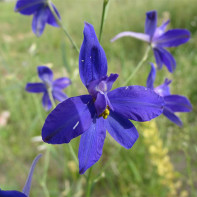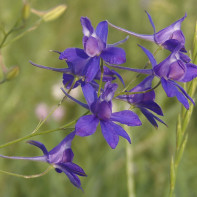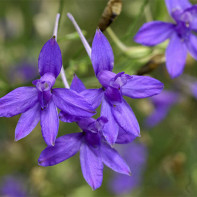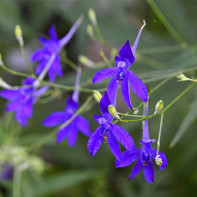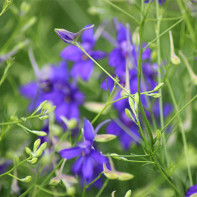Larkspur: medicinal properties and contraindications.
In the wild, larkspur is found everywhere: in forests, in meadows, near rivers. This plant with beautiful flowers more than 100 years ago took a fancy to gardeners. Breeders also liked the graceful flower, and they created about two dozen ornamental larkspur species. But this herbaceous plant won nationwide love not for its outward attractiveness, but for its powerful medicinal properties.
- Chemical Composition
- What it looks like and where it grows
- Distribution area
- External characteristics
- Types
- Harvesting and storage
- Therapeutic properties of field larkspur
- What diseases can be treated with larkspur
- Field Larkspur in folk medicine
- Remedy for uric acid diathesis
- Infusion for paralysis
- Medicine for multiple sclerosis
- For the treatment and prevention of cancer
- Infusion for cystitis
- Moisture solution
- Pain relief after injuries
- Healing Potion
- Healing compositions
- Infusion
- Tincture
- Decoction
- Ointment
- Contraindications to use
- Signs of intoxication
- Magic properties of larkspur
From time immemorial, larkspur has been used to treat wounds, intestinal disorders and even tuberculosis - a disease that was called "consumption" in common parlance. In modern medicine, this useful plant has also found a use. Some species of larkspur are used to prepare medicines, and in folk medicine for each disease also has its own recipe. But before studying the ways of treatment with the use of a medicinal plant, it is advisable first to get acquainted with the features of its composition, what diseases can be treated at home with its help, how to properly harvest valuable plant raw materials.
Chemical composition
The composition of the humble plant, which can be found everywhere, is so complex that after studying it, the true meaning of the widespread expression about deceptive appearance becomes clear. This peculiarity of larkspur is confirmed by a whole collection of folk nicknames: spurge, horned cornflower, larkspur, sokirka, delphinium. The last name was given to the plant by the Greeks for the external resemblance of its buds to the outline of a dolphin's head. The main components of the larkspur composition:
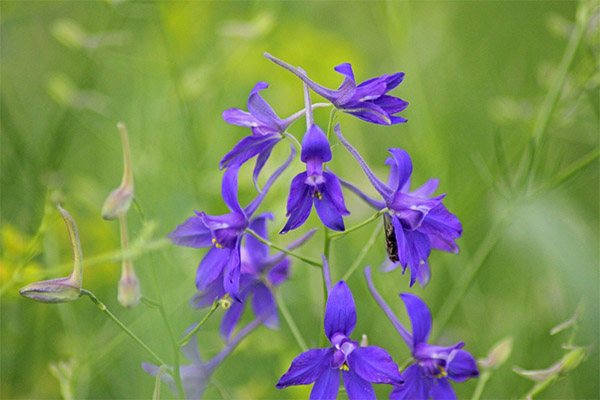
- Alkaloids are present in all parts of the plant, but their concentration is especially high in the roots and fruits.
- Organic acids.
- Flavonoids, which strengthen blood vessels, stimulate the production of bile.
- Glycosides and tannins.
- Anthocyanins, which have anti-inflammatory and antibacterial properties.
- Kempferol, which is a strong natural antioxidant.
- Minerals: zinc, potassium, copper, magnesium.
The concentration of individual substances may vary depending on the species of larkspur. But the highest content of alkaloids is noted in ornamental varieties of the plant, so they are considered poisonous.
What it looks like and where it grows
Different species of larkspur differ greatly in appearance. In total, there are more than three hundred species worldwide, most of which are wild.
Distribution range
Larkspur, as a species of wild flora, adapts well to environmental conditions. The plant is equally distributed in both hemispheres. In the Russian expanses, the grass is found in the Caucasus and in the middle belt, in the west of Siberia. In neighboring Ukraine and Belarus, you can also see single bushes of larkspur and solid thickets everywhere in the arable fields and along the roads. In general, all common species are poisonous. The only difference is the level of toxicity of a particular variety.
External Characteristics
Larkspur grass comes in single- and biennials, which also depends on the species. The plant is a member of the buttercup family.
- The height of an adult plant varies depending on the variety from 50 cm to 1 m and more.
- Leaves are lobed, cusped or dentate along the edges.
- Inflorescences of a bright purple or blue hue are located at the very tip of each branch. Occasionally there are wild species with white and pink flowers gathered in a long brush.
- The blooming period of the larkspur lasts all summer. It is for this feature that gardeners love this plant and willingly grow ornamental varieties on their garden plots.
- The upright stem in the upper part is branched and the root is rod-shaped.
You can also add that larkspur is not too demanding to the soil, well acclimated to forest edges, vacant lots, in meadows.
An important point! For the similarity of names, larkspur is often confused with comfrey, which is also included in the list of the most popular plants in medicine. But comfrey is a member of the Buranaceae family, it has a completely different flower structure.
Species
Among the medicinal species of delphinium, only 4 varieties are common in the wild. Let's consider in detail the features of each variety of flower.
Zhivostka field is found throughout the European part of Russia and neighboring countries. This grass clogs the fields where agricultural crops are grown. But this species is not as toxic as the others; on the contrary, it is a good honeybee. That is why bees swirl over fields with this plant all summer long. By the way, honey collected from the flowers of the field sap has exactly the same powerful medicinal properties as the annual plant itself. Only the seeds and leaves are harvested as medicinal raw materials. The wildflower is widely used in pharmaceuticals and folk medicine. Decoctions and infusions help fight diseases of the gastrointestinal tract and nervous system, they are effective for worm infestations and headaches. Since the plant has diuretic properties, healing solutions on its basis, doctors advise to take with cystitis. The flowers of the plant have pronounced anti-inflammatory and expectorant properties.
Tall larkspur is the most poisonous. It is a perennial that reaches up to 2 m in height. It was this species that became the basis for obtaining most ornamental varieties of delphinium. Only the flowers do not contain poisonous substances, but still high larkspur should be handled very carefully, and all medicines involving the herb should be taken under medical supervision.
Despite its high toxicity, this species is in demand in medicine. Solutions based on it are used in folk medicine to treat burns, inflammatory processes and even cancer. The high content of alkaloids provides a powerful analgesic effect, comparable in strength to the action of some narcotic drugs.
The reticulate larkspur is a thermophilic species. It is found in the south and east of all of Russia. A distinctive feature of the composition of this variety is the high content of curare-like myorelaxants. These substances relax muscle tone and spasms. Medicinal forms with the herb of this species help with cramps, diseases of the digestive organs. The reticulate larkspur inhabits vast areas in the Altai Territory, but the main raw material for the production of medicines is collected in the special climatic zone of the Dzungarian Alatau. Only the aboveground part is suitable for making medicines, but more often the inflorescences are used.
Note: Mellictin, a well-known medicine widely used in neurology for treating arachnoiditis, Parkinson's disease and other brain pathologies against the background of increased muscle tone, is made from reticulate larkspur.
The apothecary species of larkspur is a biennial up to 1 m tall. It occurs only in the Balkans and Turkey. Russian dachnikov grow it to decorate the garden area. Apothecary larkspur is widely used in folk medicine. In principle, it is a universal natural raw material for preparation of various medicines for a whole list of diseases. For example, the herb of the drugstore kind will be useful to women with menstrual disorders. And external application in the form of compresses and lotions will help relieve severe pain and swelling in injuries. Well heals the herb boils and purulent wounds, helps relieve symptoms of rheumatoid arthritis. Often in worm infestations in children, folk healers recommend to direct to the fight against parasites the possibilities of this plant.
Here are only the most common species of larkspur. But there are rare and even almost extinct varieties, like wedge-shaped and Ural larkspur.
Delphiniums are very popular today. The plant is massively used in landscape design, it is grown from seeds in arboretums. Thanks to the efforts of breeders, more than a dozen cultivars of larkspur have been bred.
Good to know! Mass distribution of the toxic plant often leads to poisoning of cattle that graze in meadows in summer. In some regions, there have even been cases of mass death of bees.
Collection and Storage
The collection of grass should be taken very seriously. Any violation of the rules, which will be given below, can end in tragedy. You should initially learn that you will have to deal with a very toxic plant. Here are the requirements to remember:
- First of all, make sure that this is the exact species to be harvested.
- To avoid catastrophic consequences, work with lively plants wearing gloves.
- After completing the process of collecting plant material carefully, preferably several times, wash your hands with soap and water.
- On no account should the pollen get on the mucous membranes of the eyes and mouth.
This is regarding the rules of safe collection. Now about how to collect valuable plant raw materials. It is necessary to act very carefully, avoiding the ingress of other plants, dirt, small debris in the collected material. You can collect medicinal grass only in places of its intensive growth, but not near highways. Begin harvesting larkspur during the formation of buds, but before it begins flowering.
- The top of the stem together with the leaves and inflorescence should be harvested. Therefore remove a piece of 40-70 cm from the top of the plant.
- Then the leaves are separated from the stems, and then all of the raw material is spread out on paper for drying.
- The ideal place for drying plant material is in the attic, but you can carry out this process under a roof.
- When dried in a machine, if you keep the temperature no higher than 50 ° C, you get the same quality raw material as in the natural process.
- It is strictly forbidden to taste the raw material.
- The herb is regularly turned over to prevent the appearance of mold.
- It is possible to collect material from the same site only after 2 years.
- Larkspur roots are usually collected in early spring or late autumn. The process of preparation for drying and the conditions are similar to the methods described above.
- When the plant material is ready and well dried, it is stored in paper bags or a cardboard box. Canvas bags are suitable for this purpose. Allowable period of storage - 2 years.
Attention! Gardeners engaged in the cultivation of ornamental varieties of larkspur also need to strictly follow the safety rules during the care of the toxic plant. Plots where larkspur grows, it is necessary to fence in order to prevent accidental contact with the dangerous plant of children and pets.
Medicinal properties of larkspur
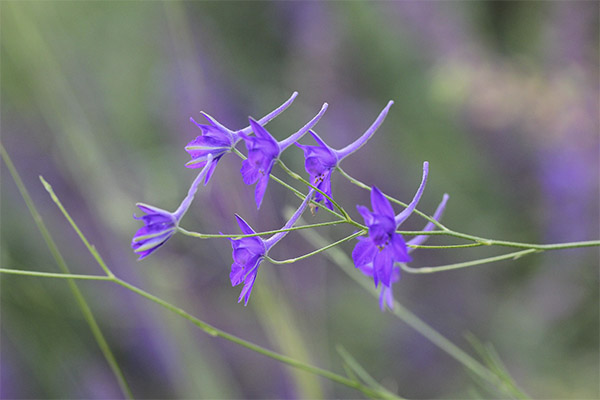
As noted above, the field and apothecary species of larkspur are in demand in the pharmaceutical industry. Therefore, the valuable plant is grown specifically to produce raw material for the production of anticonvulsants, external agents for treating wounds and other medicines that are in demand in medicine today. Despite the species difference, the therapeutic properties of the plant in some varieties are the same. In general, the following therapeutic effects can be identified:
- diuretic;
- expectorant;
- anti-inflammatory;
- antiseptic;
- astringent;
- analgesic;
- antiparasitic;
- anticarcinogenic.
But most valued larkspur for its alkaloid content, which can relax muscle tone in patients with paralysis and severe disorders of the musculoskeletal system.
Important! All parts of the plant are used to prepare medicines. But it is taken into account that the concentration of toxic substances in different elements of larkspur differs significantly. This fact must be taken into account by supporters of folk methods of treatment.
What diseases can be treated with larkspur
The name of the plant "larkspur" directly indicates its ability to heal bones. Therefore, in folk medicine it is often used for the following pathological conditions:
- bone fractures;
- sprains;
- bruises;
- inflammatory processes of the joints;
- gout;
- osteochondrosis;
- rheumatism.
For the treatment of such conditions are mainly used external remedies: ointments, solutions for compresses and rubbing, balms. Such compositions are prepared not only from the ground part of the herb, but also from the roots, which contain most of the alkaloids.
Attention! Since such procedures require direct contact with medicines, you should wash your hands thoroughly after carrying out them.
In addition to the treatment of pathologies of the bone tissues and joints, delphinium with the permission of the doctor can be used as an additional component of general therapy for such diseases:
- epilepsy;
- multiple sclerosis;
- kidney disease;
- Digestive disorders and diseases of the gastrointestinal tract;
- Open wounds, including burns;
- Pleurisy and other respiratory diseases;
- Conjunctivitis and blepharitis;
- helminth infections.
As practice shows, auxiliary remedies with larkspur, prepared according to folk recipes, increase the result of the main therapy. Recently, scientists conducted studies that showed that delphinium is able to regulate metabolic processes in the human body. This makes a useful plant promising in the fight against excessive kilograms. To these pluses we would like to add another one: homemade creams with a small portion of bellies will help get rid of acne and pimples. In cosmetology, the components of the plant are often added to rejuvenating products for aging skin. This fact once again confirms the versatility of the medicinal plant.
Mildew in folk medicine
Although folk healers, as well as physicians, are very cautious about the possibility of using a poisonous plant for medicinal purposes, such practice is widespread not only in our country, but also abroad. It is no accident Paracelsus and Hippocrates thousands of years ago said that everything useful can become a poison, as well as a poison at the right dose can turn into a cure. Therefore, if you follow the rules for preparing the dosage forms, and strictly observe the indicated dosages, this kind of treatment will be effective and safe.

Before studying the experience of folk healing, represented by the best recipes with larkspur, we would like to make a little excursus to the past.
A little historical background
As early as the 19th century, scientists discovered alkaloids in larkspur, which acted like the famous curare poison. This toxic substance was derived from a mixture of several poisonous plants and then smeared on arrowheads. When the poisoned arrow hit an animal or human body, the victim was instantly killed because a complete paralysis of the central nervous system with respiratory failure ensued. It was a powerful weapon that terrified the colonizers. But in medicine, this property of the plant is used in surgery. For example, preparations with curare-like components are used for local anesthesia during operations.
In the modern practice of folk medicine, different medicinal forms with larkspur are used: ointments, decoctions, powders, infusions, fresh juice and honey from the flower pollen of the plant. All of the above remedies are not difficult to prepare at home. Here are a few of the most popular recipes as an example.
A remedy for uric acid diathesis
This pathology is characterized by a metabolic disorder, which leads to increased synthesis of uric acid salts. Typically, this disease is associated with poor diet.
An infusion is prepared from 3 tablespoons of lively grass and 1 liter of steep boiling water, which should be put on the plant material. After two hours of infusion drink take before eating 100-150 ml.
Infusion for paralysis.
The scheme of preparation of homemade medicine is almost the same as in the previous case, but the initial components are taken in other quantities:
- Dried, grinded into a powder herb - 1 tbsp.
- Boiling water - a full glass.
Insist the healing composition for 2-4 hours. Drink ½ cup up to 4 intakes per day.
A remedy for multiple sclerosis
To treat this serious disease, you will need to prepare a decoction of 1 tsp of dried bellies and 0.4 liters of water. Boil the solution for a quarter of an hour, then cool and filter. The dose for one reception is 1 tsp. decoction. The standard course of treatment is 2 weeks, but if necessary after a short break the therapy can be resumed.
For the treatment and prevention of cancer
In the home treatment of malignant tumors has long justified itself an infusion of powder of herb larkspur, prepared in the proportion: 1 tsp of raw materials 2 cups of boiling water. After two hours of infusion healing drink will be ready. Take a third of a cup on an empty stomach.
Infusion for cystitis
This remedy is prepared from the flowering plant. You will need to take about 20-30 grams of fresh grass, pour it with 1 liter of boiling water. The solution should infuse well, which will require 2-3 hours. Drink half a glass three times before meals.
Solution for lotions
Prepared according to this recipe composition will accelerate the healing of burn surfaces, as well as help in the treatment of infected wounds and pustules. The remedy is prepared according to the following scheme: 1 tbsp. of lively roots (pre-crush them) should be boiled with a glass of water. Infuse the solution for an hour, and then make sure to strain it. In the infusion at room temperature soak a cloth or a piece of gauze, and then make lotions for half an hour on the affected areas.
Important: It is necessary to carry out the procedure very carefully, trying not to get the solution in the eyes and mouth.
Remedy for pain after injury
To prepare such a preparation, you will need fresh roots of larkspur. They should be chopped finely, then pour boiling water over them. The ratio of components is 1:2. When the composition cools a little, you need to wrap the roots in a cloth, and then apply to the painful place. Such compresses with severe pain can be repeated 3-4 times.
Healing remedy
In this case, too, it is necessary to prepare a composition for compresses. But it will no longer be an infusion, but a medicinal mixture of the following components:
- Water.
- Powder from the root of the larkspur.
- Vegetable oil (any).
Take all these components in equal quantities. Apply the resulting mush to the site of a fracture or a painful joint. Wrap the compress with a warm scarf or a piece of cloth. To ensure that the compress does not restrict movement, you can secure the construction with a special bandage. It is advisable to perform the procedure at night. In the morning, it is necessary to rinse the healing composition from the skin.
Types of medicinal compositions
All medicinal forms, which are prepared according to folk recipes, are time-tested. As the above recipes show, there are variations in the preparation of some medicines. For example, tinctures and decoctions are prepared for different pathologies according to a different scheme. The use of different variants allows you to get a drug with the right concentration of useful substances. But despite the existing differences in the way of making medicines, there are common standards, which have been strictly observed for centuries. So, tinctures are prepared on an alcohol base, decoctions and infusions - on water.
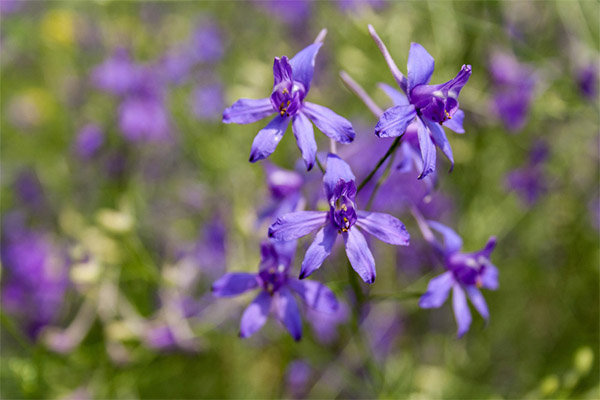
Infusion
Anti-inflammatory infusion. For 1 tsp of dry raw materials you will need 500 ml of boiling water. After combining the components cover the container with a lid, and over wrap with a towel. Insist healing drink should be at least 8 hours. Take the medicine when you have a bad cough or a cold, 1/2 cup up to 4 times a day.
The second version of the healing infusion does not require such a long exposure. It is necessary to steep 1 tbsp. herb in boiling water, then the solution should insist for an hour. Drink a whole glass, but no more than 3 times a day.
Tincture .
This home remedy will help to cope with inflammatory processes of the urinary tract. For 1 part of the herb, you will need to take 10 parts of vodka. Mix all the ingredients, let it insist for 10-14 days. Take up to 5 times for 5 drops.
Decoction
This recipe is considered an excellent remedy for the normalization of the liver with hepatitis. The remedy is prepared according to the following formula: per part of the dry drug take 10 parts of water. Put the solution on a low heat. Let the broth boil for 10 minutes, when it cools, be sure to filter the drink. Take 1 tsp. before meals. The solution obtained in this simple way can be used for external treatment of burns, and as a pain reliever for injuries and bruises to make lotions.
Ointment .
As a rule, to prepare a homemade ointment for rheumatic pains, injuries and osteochondrosis use larkspur. Initial components:
- The seeds of the plant - 1 tsp.
- Nutritional fat - 10 tsp.
Algorithm of action:
- First, combine the above ingredients.
- Then mix well.
- Allow to stand for 10 days.
- Ready to apply the ointment twice to the problem areas in a thick layer.
Contraindications for use
Given the high toxicity, lively in some situations is strictly forbidden to use for therapeutic purposes. The list of absolute contraindications includes:
- Pregnancy and lactation period;
- Age under 18 years of age;
- stable hypotension (low blood pressure);
- myasthenia gravis;
- cardiac abnormalities;
- general weakness;
- decreased muscle tone.
Nursing mothers and pregnant women are allowed to use compositions based on the herb only for external treatment. But such treatment is allowed with strict adherence to safety rules. Any kind of self-treatment with toxic preparations is unacceptable, because violation of the rules of preparation of the drug, as well as exceeding the dosage, can lead to serious poisoning.
Signs of intoxication
When poisoning with stomach preparations, convulsions appear, oppression of respiratory functions is noted, there may be vomiting. Such a clinic requires emergency medical care. If the correct action is not taken in time, everything can end in death.
Magical properties of larkspur
The herb larkspur is considered one of the oldest plants on Earth. It was actively used in ancient times and during the Middle Ages. In our days, its magnificent possibilities have also found wide application in different spheres. For many years of service for the benefit of man, many beliefs associated with the power of this flower have appeared in the people.
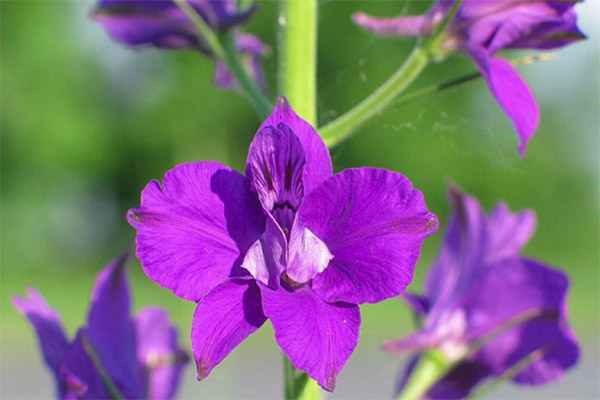
For example, even today there is a belief that a dream delphinium flower promises a good marriage or finding true friends.
- We Slavs in ancient times, there was a custom: over the front door, they fixed a bunch of dry grass larkspur. It was believed that this method reliably protected the house from evil spirits and uninvited guests.
- Only blue blossoms of the plant were used as a personal talisman. They were dried and then put into a small bag. Such protection against the evil eye was worn on the chest.
- Dried inflorescences of larkspur were placed under the pillow to ward off nightmares and ensure a restful sleep.
- The herb was not less actively used for preparation of a charm potion, because in ancient times, delphinium was considered a flower of love. And the plant acted equally effectively in two directions: helped to attract a beloved, and also protected from an undesirable spell.
In spite of its simple appearance, the plant larkspur is endowed with a great healing potential. But when handling it, you need to clearly follow the recommendations given here, so that the useful herb will really heal, not harm your health.
«Important: All information on this site is provided solely for introductory purposes only. Consult with a specialist before applying any recommendations. specialist before applying any of the recommendations. Neither the editors nor the authors shall be liable for any possible harm caused by materials."

